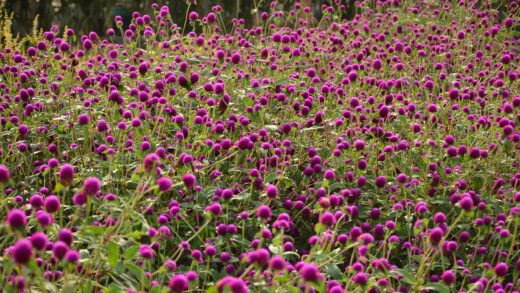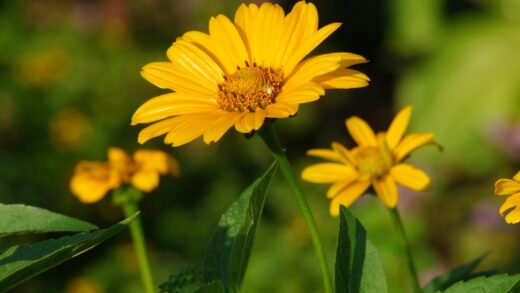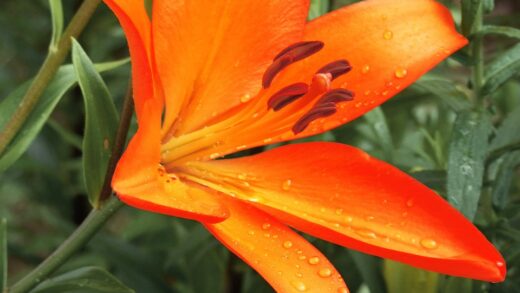The single most important environmental factor for the successful cultivation of purpletop vervain is an abundance of direct sunlight. This is a plant that is fundamentally programmed to thrive in open, sun-drenched landscapes, and its entire growth habit, from its sturdy stems to its prolific flowering, is dependent on receiving adequate light. Providing insufficient sunlight is the most common reason for gardeners to be disappointed with its performance. To achieve the iconic airy structure and clouds of purple blooms, placing this plant in the sunniest possible location in your garden is not just a recommendation, but an absolute necessity. Understanding the profound impact of light on this species is the key to unlocking its full ornamental potential.
The requirement for full sun is a direct reflection of the plant’s evolutionary history. Originating in the grasslands and open savannahs of South America, it is adapted to an environment with little to no overhead canopy, where it competes for light in a tall, grassy matrix. This has driven it to grow tall and to flower at the tips of its stems, holding its blooms high to attract pollinators. When we bring this plant into a garden setting, we must respect this ingrained need for bright, direct light to allow it to express its natural character. A shady spot will fundamentally inhibit its ability to grow and flower as it should.
The duration of sunlight is just as important as its intensity. For optimal performance, purpletop vervain requires a minimum of six hours of direct, unfiltered sunlight each day. Eight or more hours is even better. This sustained period of high light intensity fuels the process of photosynthesis, providing the energy the plant needs to build strong stems, healthy foliage, and, most importantly, a profusion of flowers. Anything less than six hours will result in a plant that is visibly struggling, with weaker stems and significantly fewer blooms.
It is also important to consider the quality of the light throughout the day. Morning sun is beneficial as it helps to dry dew from the leaves quickly, reducing the risk of fungal diseases. However, the intense afternoon sun is particularly valuable for this heat-loving plant. When selecting a planting site, observe the patterns of sun and shade in your garden throughout a full day to identify a location that receives the longest possible period of direct solar exposure. This careful siting is the most critical decision you will make for the long-term health and beauty of your verbena.
The fundamental need for full sun exposure
The term ‘full sun’ in horticulture is generally defined as an area that receives six or more hours of direct, unobstructed sunlight per day, and for purpletop vervain, this is the absolute minimum requirement for acceptable performance. In a location that meets this criterion, the plant will develop the strong, self-supporting stems and dense flower clusters for which it is prized. The intense light signals the plant to invest its energy in creating a robust structure and initiating the flowering process. This exposure to direct sun is the primary driver of its overall health and vigour.
More articles on this topic
When deprived of full sun, the plant’s response is immediate and predictable. It will exhibit a condition known as etiolation, where the stems become elongated, thin, and weak as they stretch in search of more light. This results in a ‘leggy’ and sparse appearance, a stark contrast to the sturdy, upright form seen in well-sited specimens. These weakened stems are often unable to support the weight of the flower heads, causing them to flop over, especially after rain or in windy conditions. The elegant, architectural quality of the plant is completely lost in shady conditions.
The need for full sun extends beyond just the structural integrity of the plant; it is also directly linked to its flowering capacity. Photosynthesis, the process by which plants convert light into energy, is maximized in bright sunlight. This energy is essential for the production of flowers. A purpletop vervain growing in a shady spot may produce some leaves, but it will have drastically fewer flowers, and the blooms it does produce may be smaller and less vibrant. The spectacular, cloud-like floral display that makes this plant so popular is achievable only with ample sun exposure.
Therefore, when planning your garden design, you must prioritize the light requirements of this species. Do not attempt to tuck it into a partially shaded border with the hope that it will adapt; it will not. It is a plant for the sunniest, most open parts of your garden. It should be sited away from the shade cast by large trees, buildings, or dense shrubs. By honouring this fundamental need for full sun, you provide the foundational element required for the plant to thrive and perform to its full potential.
The impact of light on growth and flowering
Light is the primary energy source that fuels all of a plant’s metabolic processes, and for purpletop vervain, the quantity and quality of light have a direct and measurable impact on its growth. With sufficient sunlight, the plant is able to photosynthesize efficiently, producing the carbohydrates needed to build strong cellular structures. This results in thick, wiry stems that are capable of reaching their full height of up to two metres without needing external support. The leaves will be a healthy green colour and appropriately sized for the plant, contributing to its overall vigour.
More articles on this topic
The hormonal responses within the plant are also heavily influenced by light. High light levels promote the production of hormones that encourage branching and compact growth, leading to a fuller, more substantial plant. In contrast, low light conditions trigger the production of hormones that cause cell elongation, leading to the characteristic stretched and weak stems of an etiolated plant. This is a survival mechanism, as the plant is actively trying to grow taller to reach a source of light, but in a garden context, it results in a poor ornamental specimen.
The transition from vegetative growth to flowering is also a light-dependent process. Many plants, including verbena, use light cues, such as the length of the day, to time their flowering. More fundamentally, the sheer amount of energy required to produce hundreds of flowers can only be generated through high rates of photosynthesis. A plant in a low-light situation simply does not have the energy reserves to invest in a significant floral display. It will prioritize its own survival, maintaining its leaves and stems, over the energy-intensive process of reproduction.
Furthermore, the intensity of the flower colour can also be affected by sunlight. In bright, full sun, the purple pigments in the flowers will be at their most vibrant and saturated. In shadier conditions, the colour may appear paler or washed out. For a plant that is grown specifically for the visual impact of its flowers, providing the light necessary for optimal colour development is essential. Every aspect of the plant’s desirable ornamental qualities, from its form to its flowers, is directly enhanced by exposure to full sunlight.
Managing partial shade and its consequences
While full sun is the ideal, some gardeners may only have locations that receive partial shade, which is typically defined as receiving between three and six hours of direct sun per day. It is important to understand that growing purpletop vervain in such conditions will always involve a compromise in its performance. The plant may survive in partial shade, particularly if it receives a good amount of morning sun, but it will not thrive in the same way as a plant in full sun. You must be prepared for a less vigorous and less floriferous plant.
The most noticeable consequence of growing purpletop vervain in partial shade will be its altered growth habit. The plant will inevitably grow taller and more sparsely than it should, as it stretches towards the available light. The stems will be thinner and weaker, making them much more likely to bend, lean, or break. In these situations, providing some form of support, such as staking with bamboo canes or using a wire frame, becomes almost essential to prevent the plant from flopping over and looking untidy. This need for staking detracts from the plant’s naturally graceful, self-supporting nature.
Flowering will also be significantly reduced in a partially shaded location. The plant will produce fewer flower heads, and the blooming period may be shorter. The individual flower clusters may also be smaller and less dense. A plant that would be a cloud of purple in full sun might only produce a few scattered blooms in a shadier spot. If the primary reason for growing the plant is its spectacular floral display, then a partially shaded site is likely to lead to disappointment.
If your only available spot offers partial shade, you can take a few steps to mitigate the negative effects, although you cannot eliminate them entirely. Ensure the location receives at least the morning sun, which is cooler but still vital for photosynthesis and drying the foliage. Keep the plant well-watered but not over-fertilized, as excess nitrogen will only exacerbate the tendency for weak, leafy growth. Be prepared to provide support early in the season. However, the best advice for a shady garden is often to choose a different, shade-tolerant plant that is better suited to the conditions, rather than trying to force a sun-loving plant like purpletop vervain to grow in an unsuitable environment.
Optimizing light conditions in different garden settings
In a traditional border or flower bed, optimizing light for purpletop vervain involves strategic placement relative to other plants. Due to its height and transparent nature, it can be placed in the middle of the border without shading out smaller plants in front of it. However, you must ensure that taller, denser shrubs or perennials are not positioned to its south or west, where they would cast a shadow on it during the sunniest parts of the day. Planting it alongside other sun-loving, prairie-style plants like grasses and echinacea ensures that all the plants in that area share the same light requirements.
For gardeners using containers, optimizing light conditions is often easier, as you have the flexibility to move the pot. You can position the container on the sunniest patio, balcony, or deck available. As the seasons change and the angle of the sun shifts, you can move the pot to track the sunniest spots. This is particularly advantageous in gardens where sunny areas are limited. A container-grown verbena can be moved to follow the sun, ensuring it receives the maximum possible number of hours of direct light each day, which is crucial for good performance in a pot.
In a naturalistic or meadow-style planting, purpletop vervain is perfectly at home. Here, the goal is to replicate its native habitat. It should be planted in open areas where it will not be overshadowed by larger trees or structures. It can be interplanted with ornamental grasses and other tall perennials, creating a dynamic, layered effect. In this setting, its height is an advantage, allowing it to hold its flowers above the surrounding vegetation to catch the sun and attract pollinators. The key is to ensure that the overall planting density is not so high that it creates excessive shade at the base of the plants.
Even the architecture of your property can be used to optimize light. Planting purpletop vervain near a south-facing wall or fence can create a warmer microclimate and reflect additional light and heat onto the plant, which it will appreciate. Conversely, avoid planting it on the north side of a building or wall, as this area will be in shade for most, if not all, of the day. By carefully considering the permanent features of your landscape and the placement of other plants, you can ensure that you are providing your purpletop vervain with the sun-drenched conditions it needs to truly shine.


















